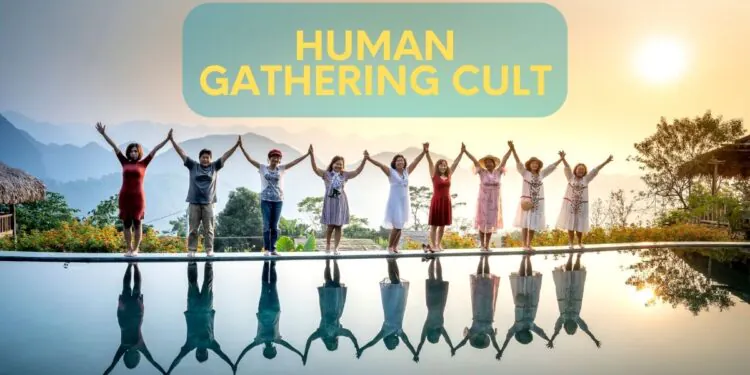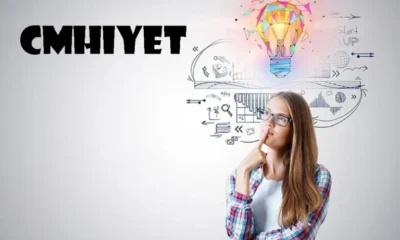ENTERTAINMENT
Unveiling the Mysteries: Inside the World of Human Gathering Cult
Published
11 months agoon

In the landscape of contemporary spirituality and fringe movements, Human Gathering Cults present a unique and often misunderstood phenomenon. These groups, characterized by their focus on communal experiences and esoteric beliefs, challenge conventional notions of spirituality and social organization. This article aims to explore the nature of Human Gathering Cults, their historical and cultural context, their practices and beliefs, and the controversies surrounding them.
Understanding Human Gathering Cults
Human Gathering Cults, as a category, refer to groups that center around collective rituals, shared beliefs, and communal living. These cults often form around charismatic leaders or founders who articulate a vision for a utopian or transformative experience. They are characterized by a strong emphasis on community and personal transformation, sometimes blending elements of spirituality, philosophy, and mysticism.
1. Definition and Characteristics:
Human Gathering Cults are defined by several key characteristics:
- Collective Rituals: Central to these groups are rituals that involve all members, often designed to create a sense of unity and shared purpose.
- Charismatic Leadership: Many of these cults are led by individuals who are seen as enlightened or possessing unique insights into human existence.
- Utopian Ideals: They frequently espouse a vision of a better world or a transformed state of being, which members strive to achieve.
- Seclusion or Isolation: Some cults practice a form of seclusion, either physically or socially, from mainstream society to foster a deeper sense of community.
Historical and Cultural Context
1. Origins and Evolution:
The concept of cults is not new. Throughout history, various groups have formed around shared spiritual or philosophical ideals. The term “cult” itself has evolved, often reflecting societal attitudes towards such groups. In the 20th and 21st centuries, Human Gathering Cults have gained visibility due to their often dramatic and publicized activities.
2. Cultural Influences:
Human Gathering Cults often draw on a rich tapestry of cultural and religious influences. They might incorporate elements from Eastern spirituality, New Age philosophies, or Western mysticism. The eclectic nature of these influences can make the beliefs and practices of such cults appear novel and enigmatic to outsiders.
Practices and Beliefs
1. Rituals and Ceremonies:
Rituals are a cornerstone of Human Gathering Cults. These ceremonies can range from daily practices to elaborate annual events. Rituals might include meditation, chanting, symbolic acts, or communal meals. The purpose is to reinforce group cohesion, facilitate personal transformation, and connect with higher spiritual or philosophical ideals.
2. Belief Systems:
The belief systems of Human Gathering Cults can vary widely but often include elements such as:
- Spiritual Enlightenment: Many cults focus on achieving a higher state of consciousness or enlightenment.
- Esoteric Knowledge: Some groups claim to possess hidden or ancient knowledge that they believe will lead to personal or collective awakening.
- Community and Connection: A strong emphasis is placed on the importance of community, often promoting ideals of mutual support and shared goals.
3. Leadership and Hierarchy:
The structure of Human Gathering Cults can differ significantly. In some, leadership is centralized and hierarchical, with a single charismatic figure at the top. In others, leadership might be more decentralized or collective. The role of the leader is often seen as crucial, with members believing that the leader possesses special knowledge or spiritual authority.
Controversies and Challenges
1. Criticism and Misunderstanding:
Human Gathering Cults often face criticism and misunderstanding from the broader public. Common criticisms include:
- Isolationism: Some cults are criticized for isolating their members from outside influences, which can be seen as detrimental to personal freedom and social integration.
- Manipulation and Control: There are concerns about the potential for manipulation and control within cults, especially if they rely on charismatic leaders who exert significant influence over their members.
2. Legal and Ethical Issues:
Legal and ethical issues can arise, particularly in cases where cults engage in practices that are seen as harmful or exploitative. These issues might include:
- Financial Exploitation: Some cults require significant financial contributions from their members, raising concerns about financial exploitation.
- Psychological Impact: The psychological impact of intense group dynamics and communal living can be profound, with potential negative effects on mental health and well-being.
Case Studies and Examples
1. Historical Examples:
Several historical examples illustrate the diverse nature of Human Gathering Cults. These include groups like the Branch Davidians, the Rajneesh movement, and the Children of God, each of which exhibited unique characteristics and faced various controversies.
2. Contemporary Movements:
In contemporary times, there are numerous examples of Human Gathering Cults, ranging from well-known groups to more obscure ones. These modern movements often reflect current societal issues and trends, adapting traditional cult characteristics to new contexts.
Frequently Asked Questions (FAQs)
Q1: What is the primary purpose of a Human Gathering Cult?
A1: The primary purpose of a Human Gathering Cult is to create a sense of community and shared purpose among its members, often centered around specific rituals, beliefs, and spiritual or philosophical goals.
Q2: How do Human Gathering Cults differ from mainstream religious groups?
A2: Human Gathering Cults often differ from mainstream religious groups in their emphasis on communal living, charismatic leadership, and esoteric beliefs. They may also practice isolation from broader society and adopt unconventional practices.
Q3: Are Human Gathering Cults inherently harmful?
A3: Not all Human Gathering Cults are inherently harmful. The impact of such groups depends on their practices, leadership, and the well-being of their members. While some may face criticisms for harmful practices, others may offer positive communal and spiritual experiences.
Q4: How do cults typically handle dissent or criticism from within the group?
A4: Cults often have mechanisms for handling dissent or criticism, which can vary from open discussion to more coercive measures. The approach depends on the group’s leadership and internal dynamics, with some cults promoting open dialogue and others suppressing dissent.
Q5: What are some common misconceptions about Human Gathering Cults?
A5: Common misconceptions include the belief that all cults are harmful, that they all practice extreme isolation, and that they are universally characterized by manipulation and control. In reality, Human Gathering Cults are diverse, and their impact can vary widely.
Conclusion
Human Gathering Cults represent a fascinating and complex aspect of contemporary spiritual and social landscapes. By understanding their characteristics, practices, and the controversies surrounding them, we gain insight into the diverse ways in which people seek meaning, connection, and transformation. While these groups may challenge conventional views and provoke debate, they also offer valuable perspectives on human community and the search for a deeper understanding of existence. As we navigate the complexities of modern spirituality and communal living, exploring the world of Human Gathering Cults can enhance our appreciation for the diverse ways in which people come together to seek purpose and connection.
You may like
ENTERTAINMENT
Yesmovies: Watch Movies & TV Series Online For Free
Published
5 months agoon
January 28, 2025
Introduction to Yesmovies
Welcome to Yesmovies, your go-to platform for watching the latest movies and TV shows online, for free. Whether you’re a movie enthusiast or just looking for some quality entertainment to pass the time, Yesmovies has something for everyone. From action-packed thrillers and hilarious comedies to heartwarming dramas and documentaries, you can find thousands of titles from around the world, all available at the click of a button.
At Yesmovies, we understand that users want a simple and enjoyable experience when watching movies and TV shows. That’s why we’ve made it incredibly easy for anyone to browse, search, and watch their favorite content. You don’t need to sign up or pay any subscription fees. With just a few clicks, you can be enjoying your favorite film or show in no time.
What Makes Yesmovies Unique?
There are many streaming platforms out there, but what makes Yesmovies stand out is its commitment to providing free and easy access to a huge variety of entertainment options. Our platform offers:
- No subscription fees: You don’t need to spend any money to watch the content available on Yesmovies.
- An extensive library of movies and shows: We’ve got the latest releases as well as a wide selection of classic films.
- High-quality streaming: Watch in the resolution that best suits your internet speed, from standard definition to HD.
- Multilingual options: Enjoy content in different languages with subtitles, making it easier for people from various countries to enjoy our services.
Yesmovies for Everyone
We’ve designed Yesmovies to be accessible to users from all around the globe. Whether you’re from the USA, India, Nigeria, or any other part of the world, you’ll find something to enjoy on Yesmovies. We cater to diverse tastes and provide a range of content in multiple languages.
Our platform is especially easy to use for those who may not be tech-savvy. We keep everything simple, from the design to the functionality, so you can focus on enjoying your favorite shows and movies without any hassle.
Is It Legal and Safe?
When it comes to online streaming, it’s important to know the legal and safety aspects. Yesmovies operates by making sure the content available adheres to safety standards, so users can enjoy a secure and enjoyable viewing experience. However, we always advise users to be mindful of their local laws and regulations when it comes to online streaming.
We take user privacy seriously and do not require you to sign up or create an account. This way, your data remains safe, and you can freely browse and enjoy the content with peace of mind.
Key Features of Yesmovies
Yesmovies is packed with features that make it easy and enjoyable to watch movies and TV shows online. Whether you’re a movie buff or just looking for a casual watch, you’ll find something that suits your needs. Let’s take a closer look at the key features that make Yesmovies stand out from the crowd.
1. Free Access to Movies and TV Shows
One of the biggest advantages of Yesmovies is that it’s completely free to use. You don’t have to worry about paying subscription fees or signing up for a premium account. All the movies, TV shows, and documentaries are available for free, and you can start watching them instantly without any hidden costs.
Whether you’re looking for the latest blockbuster or a classic favorite, you can find it on Yesmovies without having to spend a dime. This makes it a perfect platform for people who love entertainment but don’t want to pay expensive monthly fees for other streaming services.
2. Multiple Genres and Languages Available
Yesmovies has a vast library of content, and it’s not limited to just one genre or language. You’ll find movies and TV shows in all sorts of genres, including:
- Action
- Comedy
- Drama
- Horror
- Thriller
- Romance
- Science Fiction
- Documentary
In addition to these genres, Yesmovies offers movies and TV shows in multiple languages. This feature is great for users who prefer to watch content in their native language or are interested in exploring foreign films. You can easily find films in Hindi, English, French, Spanish, and more. This variety ensures that there’s something for everyone, regardless of where they’re from or what type of content they enjoy.
3. High-Quality Video Playback
We know how important video quality is when watching movies and shows. That’s why Yesmovies provides high-quality streaming options. You can enjoy videos in different resolutions depending on your internet speed and device capability. Options typically range from Standard Definition (SD) for slower connections to High Definition (HD) and even Full HD (1080p) for those with faster internet speeds.
The platform automatically detects the best quality for your connection, but you also have the option to manually adjust it based on your preferences. Whether you’re watching on your mobile phone, laptop, or smart TV, Yesmovies ensures a smooth and high-quality viewing experience.
4. Subtitle Options for Easy Viewing
Yesmovies understands that subtitles are important for viewers who may not speak the language of the film or who simply prefer watching with subtitles. That’s why we offer multiple subtitle options for most movies and shows.
You can easily turn subtitles on or off with just a click. Plus, subtitles are available in various languages, making it easier for users from different regions to enjoy content in their preferred language. This feature is particularly helpful for those watching foreign films or those who want a clearer understanding of the dialogue in a movie.
5. User-Friendly Interface
When it comes to online streaming, a simple and easy-to-use interface is key. Yesmovies is designed with the user in mind, making it easy for anyone to browse, search, and watch movies and TV shows. Whether you’re tech-savvy or not, you’ll find it a breeze to navigate through the platform.
The homepage is neatly organized, with sections like “Trending,” “Latest Movies,” and “Popular TV Shows” that help you quickly find something to watch. The search bar allows you to look up specific titles or genres in seconds. With its clean layout and straightforward design, Yesmovies makes finding and watching your favorite content a simple task.
6. Device Compatibility: Watch Anywhere, Anytime
One of the best things about Yesmovies is that it works on almost any device. Whether you’re using a smartphone, tablet, laptop, or desktop computer, you can easily access Yesmovies from your browser. There’s no need to download a specific app or worry about software compatibility.
Yesmovies is also optimized for various screen sizes, ensuring that the website adapts well whether you’re watching on a small mobile screen or a large desktop monitor. This makes it convenient for users to enjoy content on the go or at home, allowing you to watch movies and shows wherever you are.
7. Updated Content: Latest Movies and Shows
At Yesmovies, we understand the importance of keeping up with the latest movies and TV shows. That’s why we frequently update our library with new releases and trending content. Whether you’re looking for the latest Hollywood blockbuster, a popular TV series, or newly released documentaries, you’ll find fresh content regularly added to the site.
With this feature, you’ll never have to worry about missing out on the newest films or episodes of your favorite shows. Yesmovies is dedicated to providing users with timely updates, so you always have something new to watch.
8. No Account Required
Unlike other streaming services that require you to sign up or log in, Yesmovies allows you to watch movies and shows without creating an account. There’s no need to provide any personal information or go through lengthy sign-up processes. Simply visit the website, find what you want to watch, and start streaming instantly.
This makes Yesmovies incredibly convenient for users who value their privacy or simply don’t want the hassle of maintaining yet another account. It also makes it easier for new visitors to start watching right away without any barriers.
9. Save Movies and Shows for Later
If you’re browsing Yesmovies and come across a movie or show you’d like to watch later, you can easily save it to your personal list for future viewing. This feature is great for users who like to plan their movie nights or want to keep track of what they want to watch next. While you don’t need to create an account to watch, having the option to bookmark or save titles gives you flexibility.
How to Use Yesmovies (Step-by-Step Guide)
Yesmovies is designed to be user-friendly, ensuring that anyone can navigate the platform with ease. In this section, we’ll provide a detailed step-by-step guide on how to use Yesmovies to watch, download, and customize your viewing experience.
1. How to Watch a Movie or TV Show
Watching a movie or TV show on Yesmovies is simple and can be done in just a few clicks. Here’s how:
- Step 1: Visit the Yesmovies Website
Open your web browser and type in the URL for Yesmovies. Once the site loads, you’ll see the homepage featuring various categories like Trending Movies, Latest Releases, and Popular TV Shows. - Step 2: Use the Search Bar or Browse Categories
If you’re looking for a specific movie or show, simply type the title in the search bar located at the top of the page. You can also browse through categories like Action, Comedy, Drama, or use filters such as Top Rated or Latest Movies to discover something new. - Step 3: Select Your Movie or Show
Once you’ve found the movie or TV show you want to watch, click on the title. This will take you to the movie/show’s dedicated page, where you can see a brief synopsis, cast details, and available options to watch or download. - Step 4: Click “Play”
Click the “Play” button to start streaming. The video will load and play automatically. You can adjust the volume, pause, rewind, or fast-forward the video using the controls located at the bottom of the video player.
And that’s it! You’re now ready to enjoy your favorite content on Yesmovies.
2. How to Download a Movie or Show
Yesmovies also allows you to download movies and TV shows so you can watch them offline later. This is especially useful if you have limited internet access or want to save content for a road trip or flight. Follow these steps to download content from Yesmovies:
- Step 1: Choose the Movie or TV Show
Search for the movie or show you want to download by typing the title in the search bar or browsing through the categories. - Step 2: Navigate to the Download Button
Once on the movie or TV show page, you’ll see a Download button next to or below the “Play” button. Click on it to begin the download process. - Step 3: Choose the Quality
You’ll be given options to choose the download quality, such as 480p, 720p, or 1080p. Select the video quality that best suits your storage space and internet speed. - Step 4: Start the Download
Click the Download button after selecting the video quality. The download will start, and you’ll be able to track the progress in your browser’s downloads section. - Step 5: Watch Offline
Once the download is complete, you can watch the movie or show offline whenever you like. Just open the file on your device, and enjoy!
3. How to Change Video Quality
One of the great features of Yesmovies is the ability to adjust the video quality according to your internet speed and preference. Here’s how you can do it:
- Step 1: Start the Video
Once you’ve selected a movie or TV show and clicked “Play,” the video player will appear. - Step 2: Look for the Video Quality Icon
At the bottom right corner of the video player, you’ll see an icon representing the video quality (usually marked as “720p” or “1080p”). Click on this icon to open a dropdown menu with different video quality options. - Step 3: Select the Quality
Depending on your internet speed, you can choose from various video qualities like 360p, 480p, 720p, or 1080p.- If you’re on a slower internet connection, choose 360p or 480p to avoid buffering.
- If you have a strong internet connection, go for 720p or 1080p for high-definition viewing.
- Step 4: Enjoy in Your Preferred Quality
Once you’ve selected the desired quality, the video will automatically adjust to that resolution, ensuring smooth playback without interruptions.
4. How to Change Language and Subtitles
If you’re watching a foreign film or show, or if you prefer subtitles for better understanding, Yesmovies makes it easy to adjust both the audio language and subtitle settings.
- Step 1: Start the Video
After selecting and playing your movie or TV show, the video player will appear. - Step 2: Locate the Subtitle and Language Options
At the bottom of the video player, you’ll find two icons:- Subtitle Icon: This looks like a small “CC” symbol.
- Language Icon: This may appear as a globe or a speaker symbol (depending on the version of the player).
- Step 3: Change Subtitles
To change or add subtitles, click on the Subtitle Icon. A dropdown menu will appear, allowing you to:- Turn subtitles on or off.
- Select your preferred subtitle language (e.g., English, Hindi, French, etc.).
- Step 4: Change Audio Language
If the movie or show supports multiple languages, click on the Language Icon. Here, you can choose from a list of available audio tracks, such as English, Hindi, French, and others. - Step 5: Enjoy Your Custom Viewing Experience
After making your selections, the video will continue playing with your preferred settings. Subtitles will display at the bottom of the screen, and the audio will switch to the selected language.
5. Best Internet Settings for Watching Movies
Having the right internet connection is key to ensuring a smooth and enjoyable experience on Yesmovies. Here’s a quick guide on the best internet settings for streaming:
- Low-Speed Internet (Below 3 Mbps)
If your internet speed is slower, it’s recommended to watch videos in 360p or 480p quality. This will reduce buffering and allow the video to load smoothly. - Moderate-Speed Internet (3-5 Mbps)
For moderate speeds, you can comfortably stream videos in 720p HD. This offers a clearer picture without much buffering. - High-Speed Internet (Above 5 Mbps)
If you have a high-speed internet connection, you can enjoy videos in 1080p Full HD for the best viewing experience.
6. How to Save Movies or Shows to Watch Later
If you’re browsing through Yesmovies and find a movie or show you want to watch later, you can easily save it for future viewing:
- Step 1: Find the Movie or TV Show
While browsing, you’ll notice a small bookmark icon next to each movie or show title. - Step 2: Click the Bookmark Icon
Clicking the bookmark icon will save the movie or show to your personal watchlist. This list will be stored in your browser so you can come back to it later. - Step 3: Access Your Watchlist
To access your saved titles, simply click on the “Watch Later” or “My List” tab at the top of the homepage. From here, you can view your saved content and start watching whenever you’re ready.
Best Internet Settings and Requirements
To have a smooth and enjoyable viewing experience on Yesmovies, it’s important to have the right internet connection. Whether you’re streaming or downloading movies and TV shows, the speed and stability of your internet can make a big difference in the quality of your viewing. Below, we’ve outlined the recommended internet settings and requirements for using Yesmovies effectively.
1. Recommended Internet Speed for Streaming
The speed of your internet connection determines the video quality you can stream without buffering. Here’s a breakdown of the recommended internet speeds for different video qualities:
- Low-Speed Internet (Below 3 Mbps)
- Best Quality: 360p (Standard Definition)
- If your internet speed is below 3 Mbps, it’s best to stick to 360p video quality. This allows you to watch without interruptions, though the video may not be as sharp as higher-quality options. This is ideal if you’re using mobile data or have a limited broadband connection.
- Moderate-Speed Internet (3–5 Mbps)
- Best Quality: 480p or 720p (High Definition)
- For internet speeds between 3 and 5 Mbps, you can comfortably stream videos in 480p or 720p. At this level, you’ll enjoy a clearer picture and smoother playback. This speed is common for many home Wi-Fi connections and is suitable for watching on laptops, tablets, or smart TVs.
- High-Speed Internet (Above 5 Mbps)
- Best Quality: 1080p (Full High Definition)
- If you have an internet connection of 5 Mbps or higher, you can stream videos in 1080p Full HD without worrying about buffering. This speed is perfect for larger screens and offers the best viewing experience in terms of clarity and detail.
2. Mobile Data vs. Wi-Fi
If you’re using mobile data to stream Yesmovies, it’s important to manage your data usage carefully, especially if you have a limited data plan. Here are some tips:
- For mobile data: Stick to 360p or 480p quality to conserve data. Higher resolutions like 720p or 1080p can quickly use up your data allowance.
- For Wi-Fi connections: You can comfortably stream in 720p or 1080p, depending on your speed, without worrying about data limits.
3. How to Avoid Buffering and Interruptions
Buffering can be frustrating, but there are a few simple steps you can take to minimize it:
- Pause the video for a few seconds before starting playback to give it time to load.
- Close other applications or devices that are using the internet to free up bandwidth.
- If buffering persists, lower the video quality from 1080p to 720p or 480p.
4. Using Ethernet for a Stable Connection
For the best streaming experience, especially on larger devices like laptops and smart TVs, it’s recommended to use an Ethernet connection instead of Wi-Fi. Ethernet provides a more stable and consistent internet connection, reducing the chances of buffering or interruptions.
Benefits of Using Yesmovies
When it comes to watching movies and TV shows online, Yesmovies offers several benefits that make it stand out from other platforms. Whether you’re looking for convenience, a vast content library, or a completely free service, Yesmovies delivers on all fronts. Let’s explore some of the key benefits that you can enjoy by using Yesmovies.
1. No Subscription Fees
One of the biggest advantages of using Yesmovies is that it is completely free to use. Unlike other streaming services that require a monthly subscription, Yesmovies allows you to watch your favorite movies and TV shows without paying any fees. This makes it a fantastic option for people who want access to high-quality entertainment without the financial commitment.
- Free access to thousands of titles: You can watch movies, TV shows, and documentaries without ever needing to subscribe or provide payment details.
- No hidden costs: You won’t be surprised by unexpected charges or pop-ups asking for payment to unlock premium content.
2. Watch Anytime, Anywhere
Yesmovies is designed to be accessible from almost any device, making it easy for you to watch your favorite content no matter where you are. Whether you’re at home, on the go, or traveling, you can enjoy movies and shows whenever you want.
- Cross-device compatibility: You can use Yesmovies on your smartphone, tablet, laptop, or desktop computer. All you need is an internet connection.
- Mobile-friendly: The platform works smoothly on mobile devices, allowing you to watch movies on the go without any hassle.
This flexibility means that you don’t need to be tied to your TV or a specific app—you can access Yesmovies through your browser from virtually any internet-enabled device.
3. Extensive Library of Content
Yesmovies boasts a huge collection of movies and TV shows from various genres and regions. Whether you’re in the mood for an action-packed thriller, a heartwarming romance, or a gripping documentary, you’ll find something to suit your taste.
- Latest movies and TV shows: Stay up to date with the newest releases and trending content, as Yesmovies frequently updates its library.
- Wide variety of genres: From comedy and drama to horror and science fiction, Yesmovies offers a broad selection of genres to cater to every interest.
- Multilingual content: You can find content in multiple languages, making it an ideal platform for international viewers. Whether you prefer Hindi, English, or another language, Yesmovies offers options for diverse audiences.
4. Easy to Use for Everyone
Navigating Yesmovies is a breeze, even for users who are not particularly tech-savvy. The platform is designed with simplicity in mind, ensuring that anyone can find and watch their favorite content without any confusion.
- User-friendly interface: The clean and intuitive layout makes it easy to browse through movies and shows or search for a specific title. You won’t have to spend time figuring out how to use the platform—everything is clear and straightforward.
- Quick search feature: If you know what you want to watch, simply use the search bar to find your movie or show in seconds.
5. Save Money and Time
With Yesmovies, you save both money and time. There’s no need to subscribe to expensive streaming services or rent movies. Everything is available for free, and you can start watching instantly without needing to go through lengthy registration or payment processes.
- No account creation required: You don’t need to sign up or log in to watch movies and TV shows on Yesmovies. This saves you time and keeps the process simple and hassle-free.
- No ads interruption: Although there may be occasional advertisements, they are minimal compared to other platforms, so you can enjoy your content without constant interruptions.
6. No Need to Create an Account
Unlike most other streaming services that require you to create an account, Yesmovies allows you to watch movies and shows without signing up. This adds to the convenience of the platform, as you can access content quickly without providing any personal details or passwords.
- Privacy protection: Since you don’t need to create an account, you don’t have to share personal information, making Yesmovies a great option for those who prioritize privacy.
Frequently Asked Questions (FAQ)
We know that users may have some questions about Yesmovies and how it works. To help you get the most out of the platform, we’ve compiled a list of frequently asked questions. If you’re new to Yesmovies, this section will provide helpful answers to ensure you have a smooth experience.
Q1: How can I watch Yesmovies content?
Watching movies and TV shows on Yesmovies is simple. Just visit the website, use the search bar or browse through the categories to find the content you want, and click Play. No account creation or subscription is required, so you can start watching right away.
Q2: Can I use Yesmovies on my mobile?
Yes, you can! Yesmovies is fully optimized for mobile devices, meaning you can enjoy your favorite movies and TV shows on your smartphone or tablet. Whether you’re using iOS or Android, you can stream directly from your browser without needing to download any additional apps.
Q3: Is Yesmovies free to use?
Yes, Yesmovies is completely free. You don’t need to pay for any subscription, and there are no hidden charges. All the movies and TV shows available on the platform are free to watch, making it one of the most cost-effective ways to access entertainment online.
Q4: How can I change the video quality?
You can easily adjust the video quality while watching a movie or TV show. During playback, look for the video quality icon in the bottom right corner of the video player. Click on it and choose from options like 360p, 480p, 720p, or 1080p depending on your internet connection and device capability.
Q5: How do I turn on subtitles?
To enable or disable subtitles, simply click the subtitle icon (usually marked as “CC”) in the video player controls. You can choose subtitles in various languages, including English, Hindi, and more, depending on the movie or TV show. You can also turn off subtitles if you prefer to watch without them.
Q6: Can I download movies and TV shows from Yesmovies?
Yes, you can download movies and TV shows to watch later offline. After selecting a movie or show, you’ll see a Download button next to the “Play” button. Choose your preferred download quality (e.g., 480p, 720p, 1080p), and the download will start immediately. You can watch the content anytime, even without an internet connection.
Q7: Is Yesmovies safe and legal?
Yesmovies provides free access to a large library of content, but users should be aware of their local laws and regulations regarding online streaming. It is always recommended to use a VPN to protect your privacy while accessing any online streaming platform.

ENTERTAINMENT
Exploring im being raised by villains – chapter 36: Unveiling New Dynamics and Plot Twists
Published
8 months agoon
November 4, 2024
Im being raised by villains – chapter 36” is a popular web novel series that combines elements of fantasy, drama, and complex character development. As readers dive into Chapter 36, the story continues to captivate with its intricate plot and multifaceted characters. This chapter is particularly significant as it introduces new dynamics and deepens the ongoing narrative, offering readers both revelations and challenges. This article provides a comprehensive analysis of Chapter 36, examining its key themes, character developments, and the implications for the broader story.
Plot Overview
Chapter 36 is pivotal in advancing the storyline of “I’m Being Raised by Villains.” The chapter picks up with our protagonist, [Protagonist’s Name], grappling with the consequences of recent events. Having been raised in an environment dominated by villains, [Protagonist’s Name] faces a turning point where personal ambitions and the influence of their adoptive family intersect in complex ways.
The chapter begins with [Protagonist’s Name] at a crossroads, contemplating their future while dealing with mounting pressures from both their villainous guardians and their own internal struggles. The tension escalates when a significant revelation disrupts the status quo, forcing [Protagonist’s Name] to confront uncomfortable truths and make critical decisions.
Key Themes and Developments
- Identity and Self-DiscoveryOne of the central themes of Chapter 36 is identity and self-discovery. [Protagonist’s Name] is caught between their innate moral compass and the corrupting influence of their adoptive family. This chapter delves deeper into their internal conflict, highlighting their struggle to reconcile their personal values with the expectations placed upon them. The revelation of a hidden family secret challenges [Protagonist’s Name] to reevaluate their sense of self and their place within the narrative.
- Power Dynamics and ManipulationPower dynamics play a crucial role in this chapter. [Protagonist’s Name] must navigate the complex relationships with their villainous guardians, who wield their influence with strategic cunning. The chapter explores how manipulation and control are exerted over [Protagonist’s Name], illustrating the psychological and emotional toll it takes. This theme is further highlighted through intense interactions between [Protagonist’s Name] and key antagonists, showcasing the power struggles that drive the narrative forward.
- Betrayal and TrustBetrayal emerges as a significant theme in Chapter 36. The chapter reveals unexpected betrayals from characters previously deemed trustworthy, creating a sense of paranoia and mistrust. [Protagonist’s Name] must navigate these treacherous waters while trying to determine who they can rely on. This theme underscores the precarious nature of alliances in a world where motives are often hidden beneath layers of deception.
- Moral AmbiguityThe chapter further explores the moral ambiguity of the world in which [Protagonist’s Name] exists. It questions the nature of good and evil, as characters are forced to make difficult choices that blur traditional ethical boundaries. [Protagonist’s Name] is confronted with morally complex situations that challenge their preconceptions, pushing them to question what it means to be a hero or a villain.
Character Development
- [Protagonist’s Name]In Chapter 36, [Protagonist’s Name] undergoes significant development. Their internal struggle becomes more pronounced as they face the reality of their situation and the limitations imposed by their upbringing. The chapter showcases their growth as they grapple with new information and make decisions that will impact their future. This development adds depth to their character, making them more relatable and engaging to readers.
- Villainous GuardiansThe villainous guardians’ roles are further explored, revealing more about their motivations and the complexities of their personalities. The chapter sheds light on their past actions and the reasons behind their villainous behavior. This deeper understanding adds layers to their characters, moving them beyond mere antagonists and making them more nuanced figures within the story.
- Supporting CharactersSupporting characters also play crucial roles in Chapter 36. Their interactions with [Protagonist’s Name] reveal more about their own backgrounds and motives. Some provide critical support, while others act as antagonists, creating a rich tapestry of relationships that influence the story’s progression. The chapter’s focus on these interactions highlights the interconnectedness of characters within the narrative.
Plot Twists and Revelations
Chapter 36 is rife with plot twists and revelations that shift the story’s trajectory. One of the most shocking moments is the revelation of a hidden family secret that alters [Protagonist’s Name]’s understanding of their past and future. This twist not only adds suspense but also raises the stakes for the protagonist, driving them to confront new challenges.
Another significant twist involves the betrayal of a key character, which reshapes alliances and forces [Protagonist’s Name] to reassess their strategy. These plot twists are expertly woven into the narrative, keeping readers on edge and enhancing the overall drama of the story.
Impact on the Broader Narrative
Chapter 36 is crucial in shaping the broader narrative of “I’m Being Raised by Villains.” The developments and revelations in this chapter set the stage for future conflicts and character arcs. [Protagonist’s Name]’s journey takes on new dimensions, and the implications of their choices will reverberate throughout the subsequent chapters.
The chapter also reinforces the central themes of the series, such as the struggle between personal identity and external expectations. It challenges readers to consider the complexities of morality and the impact of one’s upbringing on their choices. As the story progresses, the consequences of the events in Chapter 36 will likely influence the direction of the plot and the development of key characters.
Conclusion
Chapter 36 of “I’m Being Raised by Villains” is a pivotal installment that enriches the narrative with new insights, character developments, and dramatic twists. The chapter’s exploration of identity, power dynamics, betrayal, and moral ambiguity adds depth to the story and keeps readers engaged. As [Protagonist’s Name] navigates the challenges presented, the stage is set for future conflicts and resolutions that will shape the course of the series.
The intricacies of Chapter 36 not only advance the plot but also enhance the reader’s understanding of the characters and their motivations. As the story unfolds, the impact of this chapter will be felt throughout the series, making it a key moment in the ongoing saga of “I’m Being Raised by Villains.”
ENTERTAINMENT
Exploring French Stream.moe: The Rise of French-Language Anime Streaming
Published
8 months agoon
November 4, 2024
In the ever-expanding world of anime, accessibility and localization play crucial roles in reaching global audiences. One significant player in this niche is Stream.moe, a platform that has gained traction for its user-friendly streaming service dedicated to anime. Recently, Stream.moe has broadened its scope by incorporating French-language options, marking a notable development in the anime streaming landscape. This article delves into the impact of French Stream.moe on the anime community and what it means for French-speaking fans.
What is Stream.moe?
French Stream.moe is an online streaming service known for offering a broad range of anime titles directly to viewers. Its distinctive feature is the provision of both subtitled and dubbed versions of popular anime series and films. Stream.moe’s user interface is designed to be intuitive, allowing users to easily search for their favorite shows and explore new titles.
The French-Language Expansion
The recent introduction of French-language support on Stream.moe represents a significant expansion of the platform’s reach. This move caters to the growing number of French-speaking anime enthusiasts who seek high-quality, accessible content in their native language.
Why French?
French is one of the most widely spoken languages in the world, and France has a long-standing love affair with anime. The French anime market is robust, with numerous conventions, fan clubs, and a strong presence in media. By offering French-language options, Stream.moe is tapping into this established market and enhancing the viewing experience for French-speaking audiences.
Features of French Stream.moe
- Subtitles and Dubs: The French Stream.moe platform provides anime titles with French subtitles and dubs, catering to different preferences among viewers. This dual option allows users to enjoy anime in the way that suits them best, whether they prefer reading subtitles or listening to dubbed audio.
- Content Library: The platform boasts an extensive library of anime series and films. With the inclusion of French language options, the library becomes more accessible and enjoyable for French-speaking users, making it easier for them to follow new releases and classic favorites.
- User Experience: Stream.moe’s interface remains user-friendly with its French-language integration. The platform’s design ensures that navigation and search functionalities are intuitive, regardless of the language in use.
Impact on the Anime Community
The introduction of French-language support on Stream.moe is likely to have several positive effects on the anime community:
- Increased Accessibility: By providing content in French, Stream.moe makes anime more accessible to a wider audience. This inclusivity helps to grow the fanbase and fosters a greater appreciation for anime in French-speaking regions.
- Enhanced Viewing Experience: French-speaking viewers can now enjoy anime with high-quality translations, which can lead to a more enjoyable and immersive experience. The availability of both subtitles and dubs ensures that viewers can choose their preferred method of engagement.
- Support for Local Talent: The addition of French dubs opens up opportunities for voice actors and translators in the French-speaking community. This can lead to increased employment and recognition for local talent involved in bringing anime to French audiences.
Conclusion
The launch of French-language support on Stream.moe is a significant milestone in the platform’s evolution and the anime streaming industry as a whole. By catering to the French-speaking audience, Stream.moe not only expands its user base but also enhances the overall anime experience for a diverse group of viewers. As the anime community continues to grow globally, platforms like Stream.moe play a crucial role in making anime more accessible and enjoyable for fans around the world.
Trending
-

 ENTERTAINMENT8 months ago
ENTERTAINMENT8 months agoExploring A Sign of Affection Chapter 3: A Deeper Connection
-

 BLOG11 months ago
BLOG11 months agoDiscovering the Digital World with about somethingnewnow net blog
-

 NEWS11 months ago
NEWS11 months agoPLLsfored: A New Era in Personalized Learning Systems
-

 BLOG11 months ago
BLOG11 months agoApplelonia Bacher Carlyle IL: A Journey Through the Heart of Illinois
-

 NEWS11 months ago
NEWS11 months agoCmhiyet: Understanding Its Definition and Significance
-

 GAMES11 months ago
GAMES11 months agoThe Rising Soccer Star: Cori Castellano Irvington
-

 Education11 months ago
Education11 months agoHellseed Crossword in Spanish: A Comprehensive Guide
-

 TECH10 months ago
TECH10 months agoTrangran: A Versatile Platform for Mapping and Marketplaces
